Презентация gene exp and hormones part 1

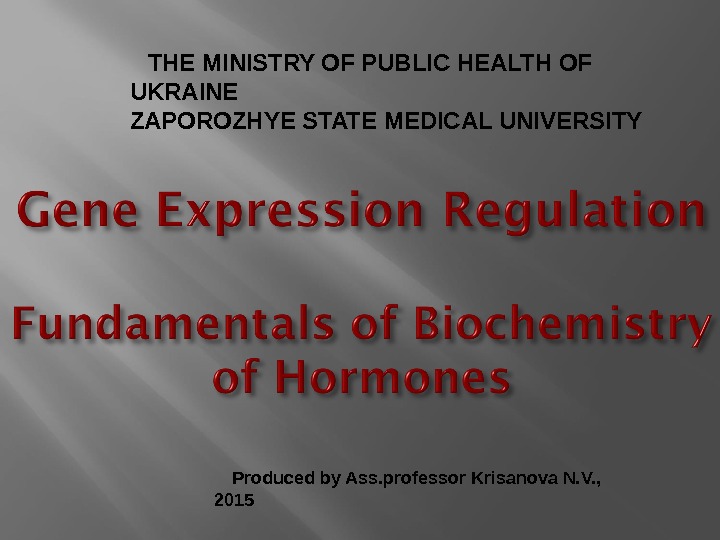
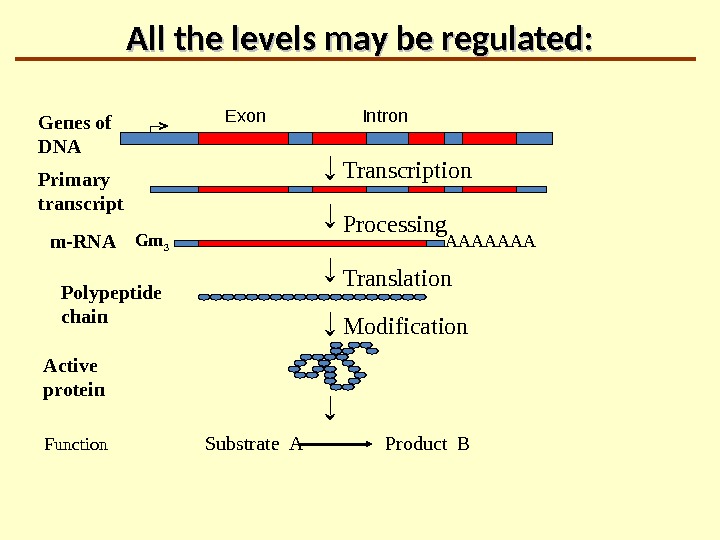
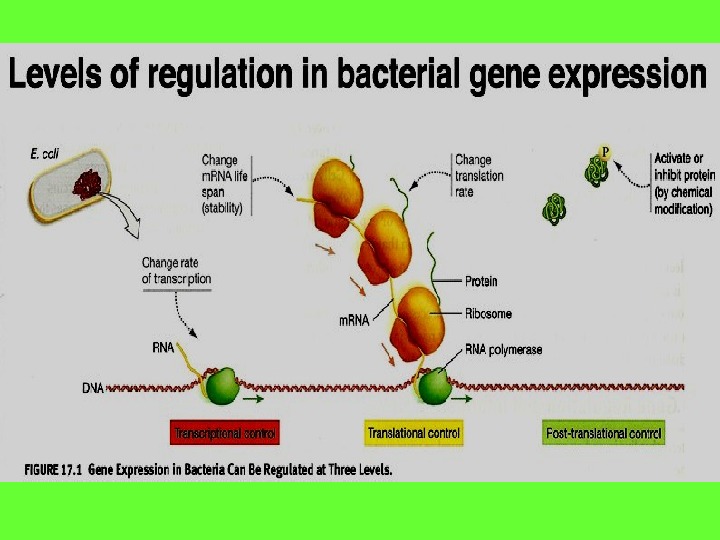
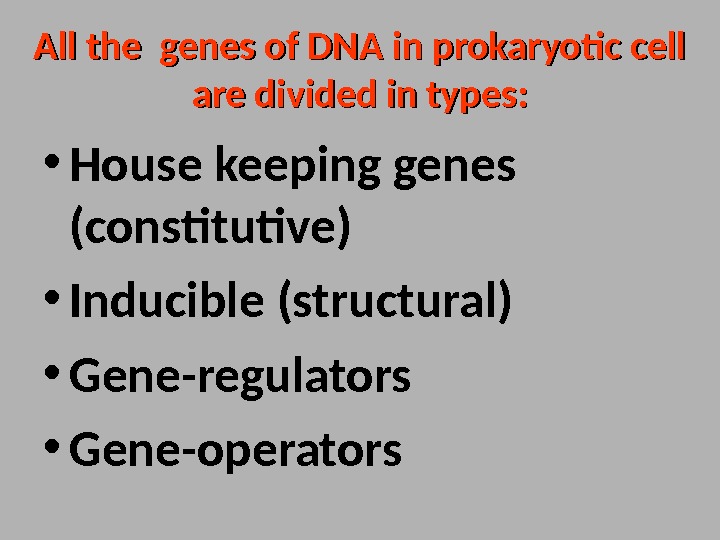
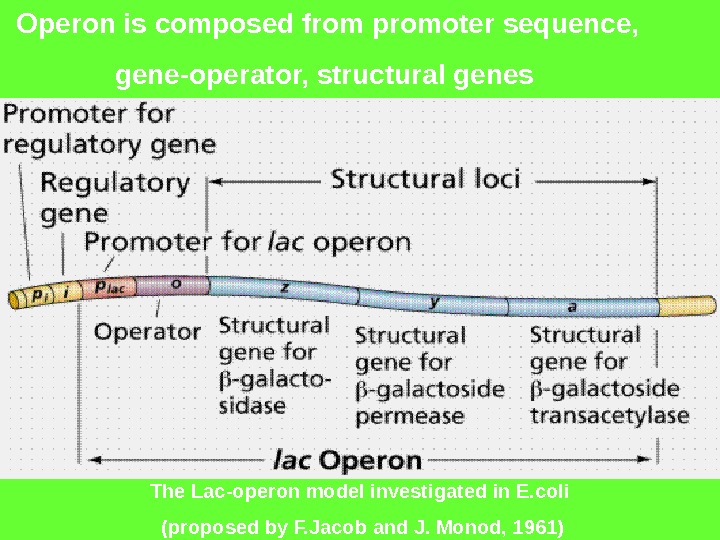
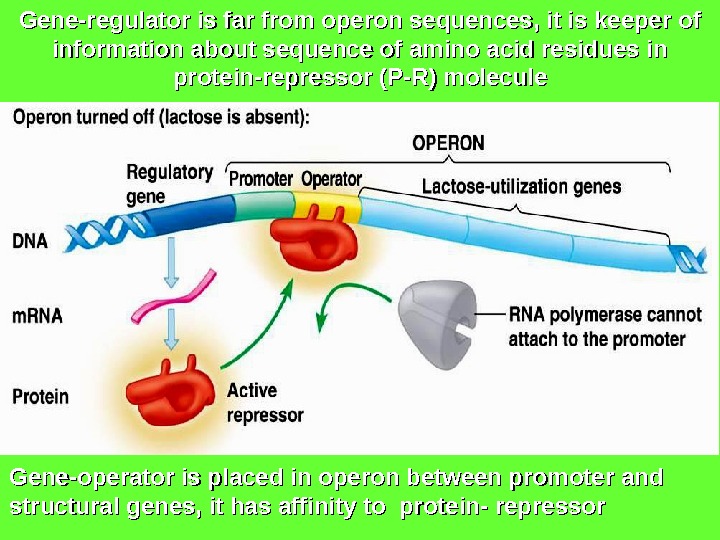
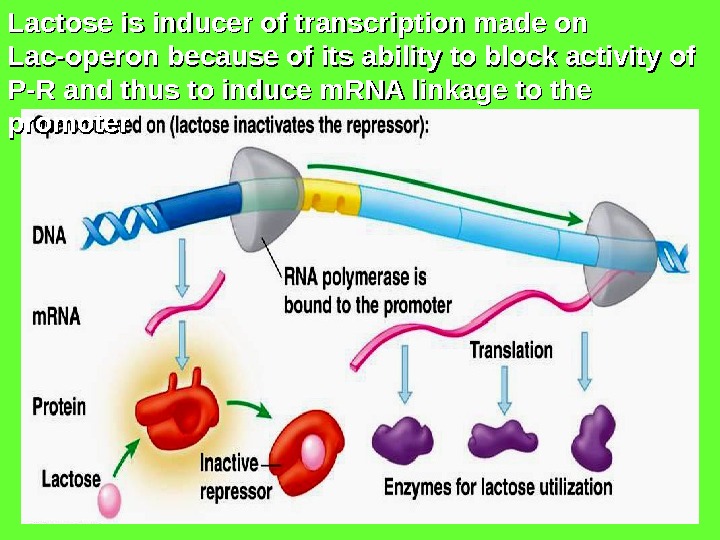
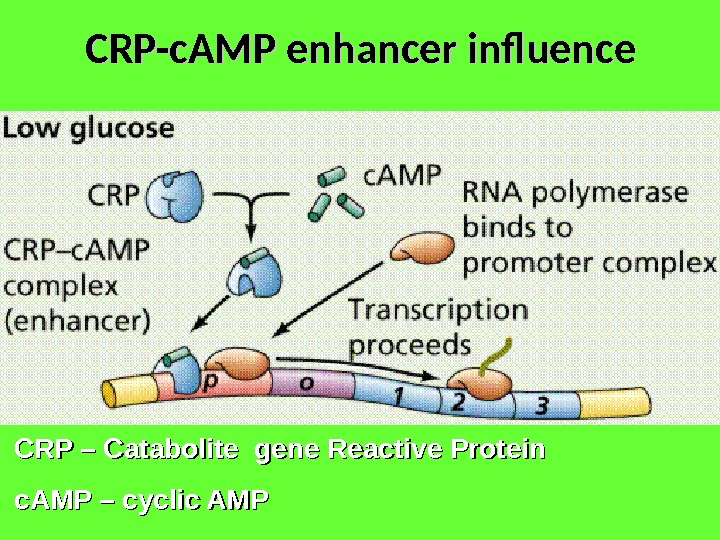
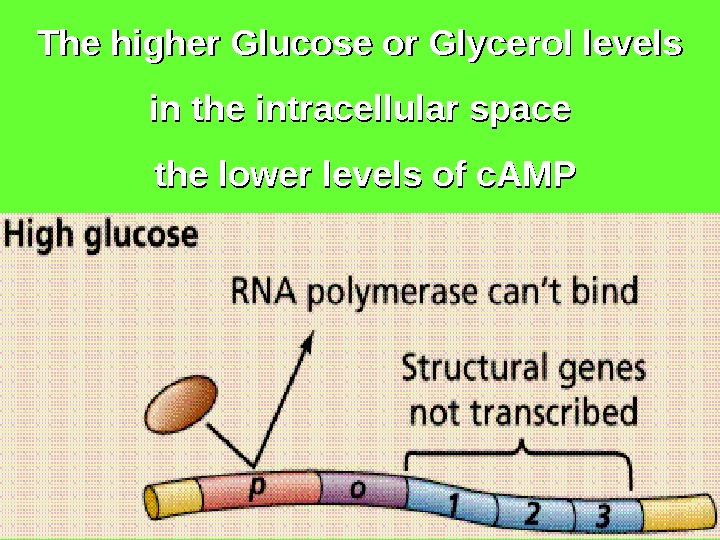
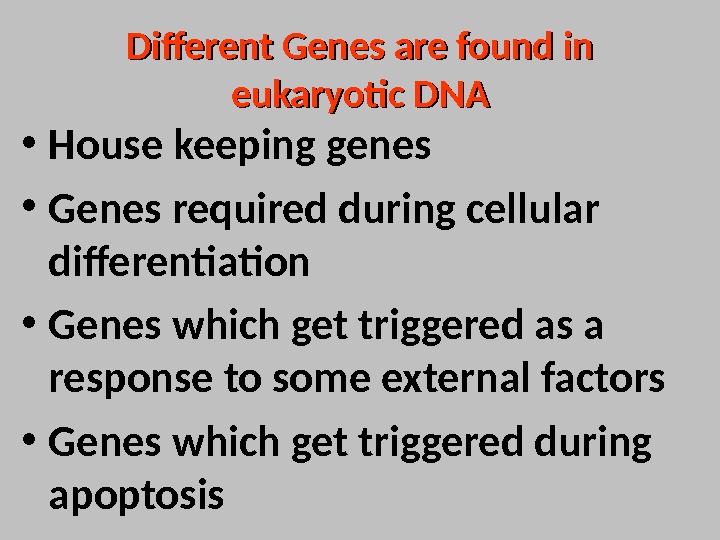
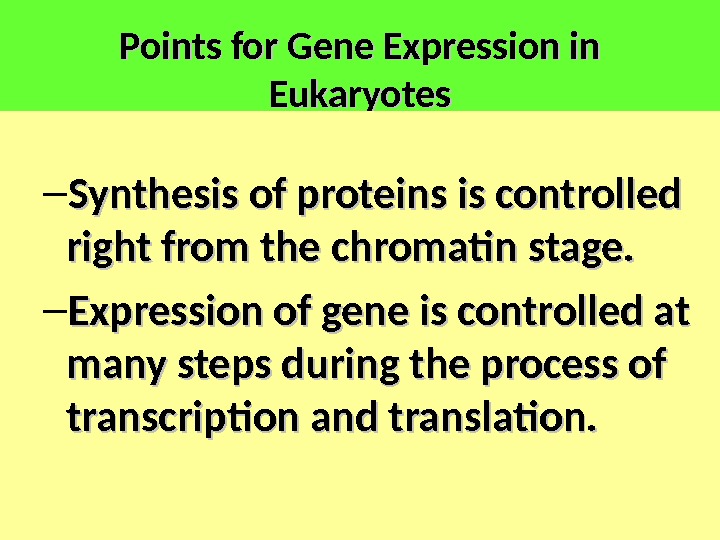
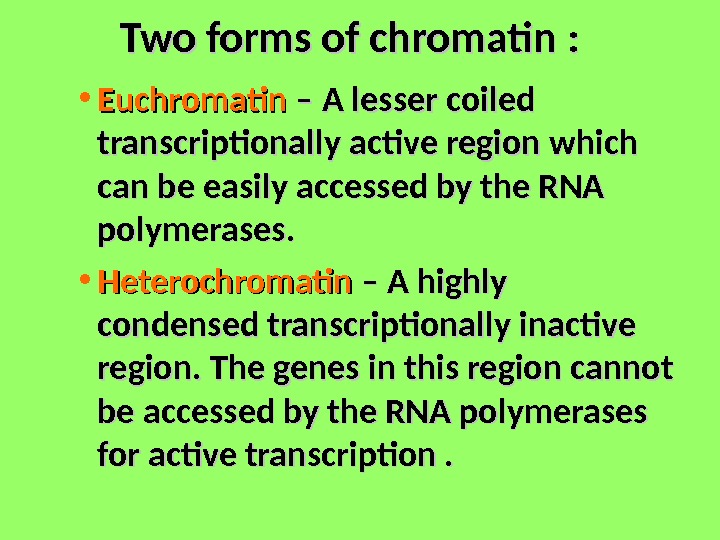
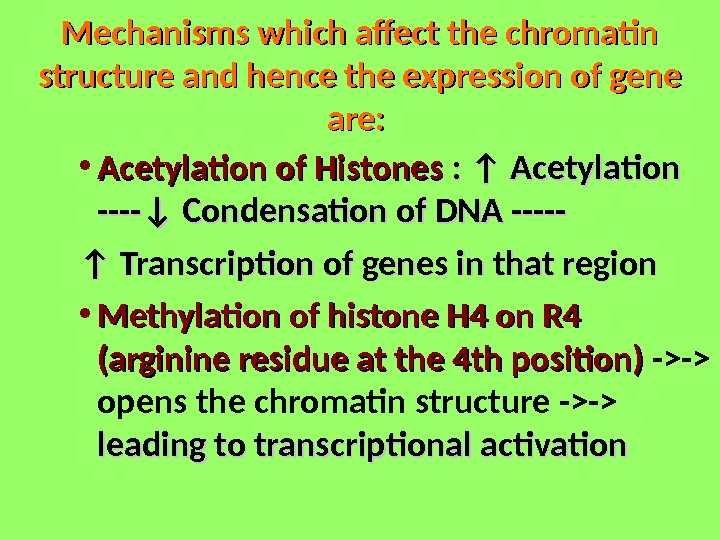
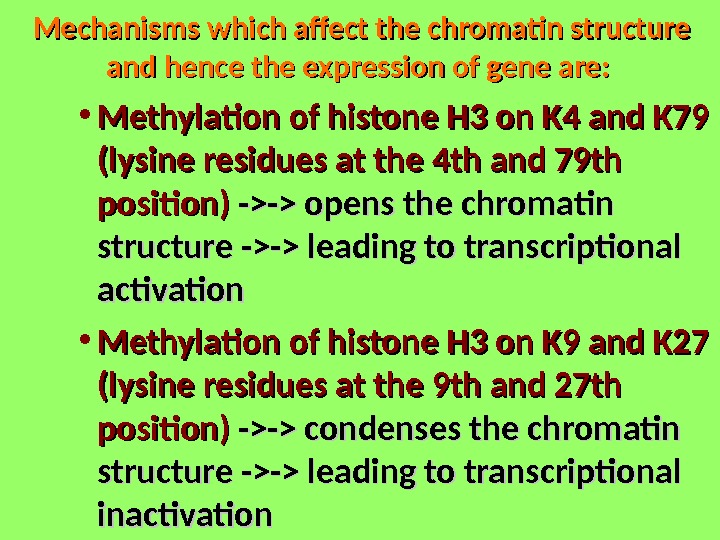
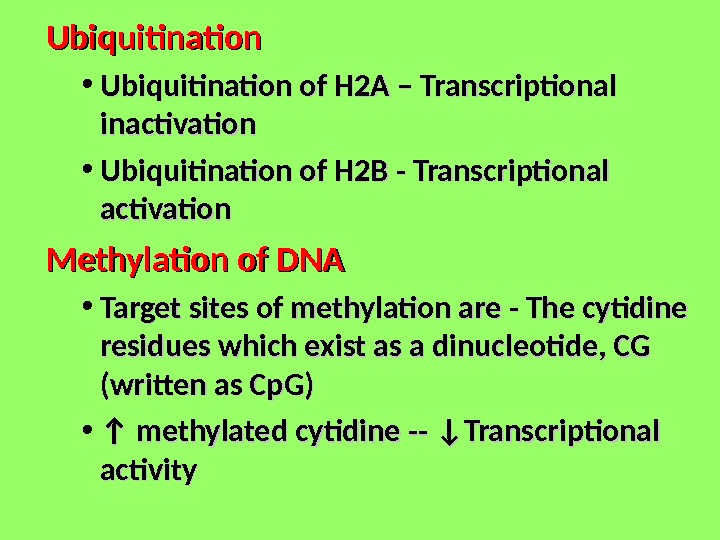
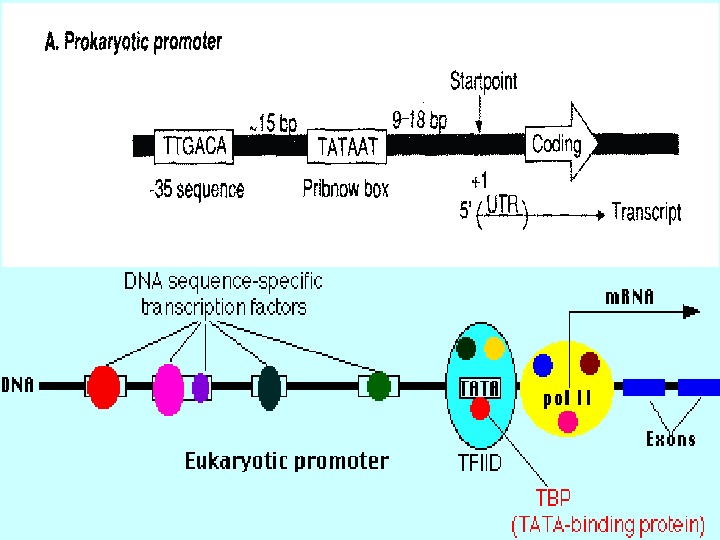
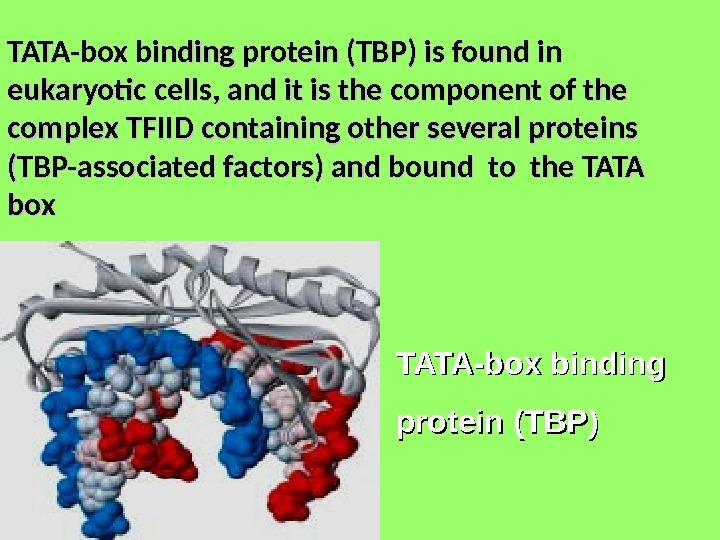
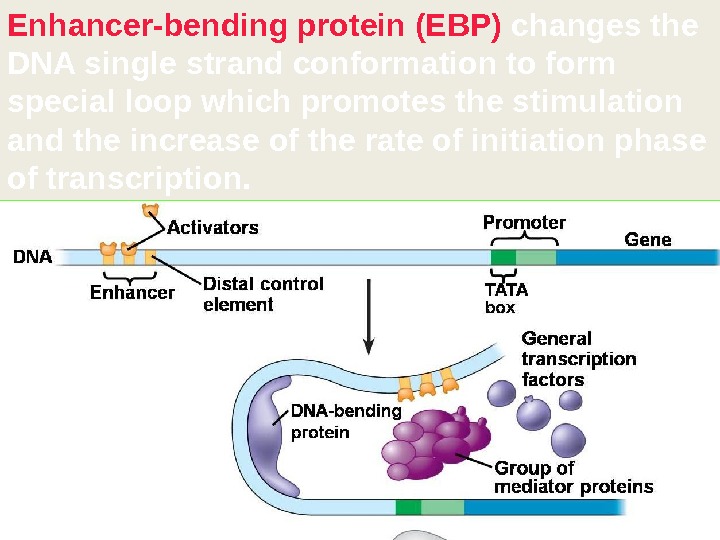
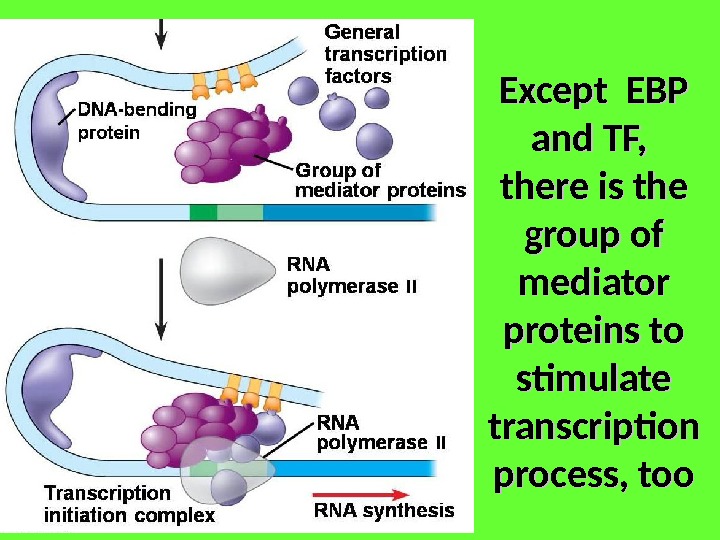

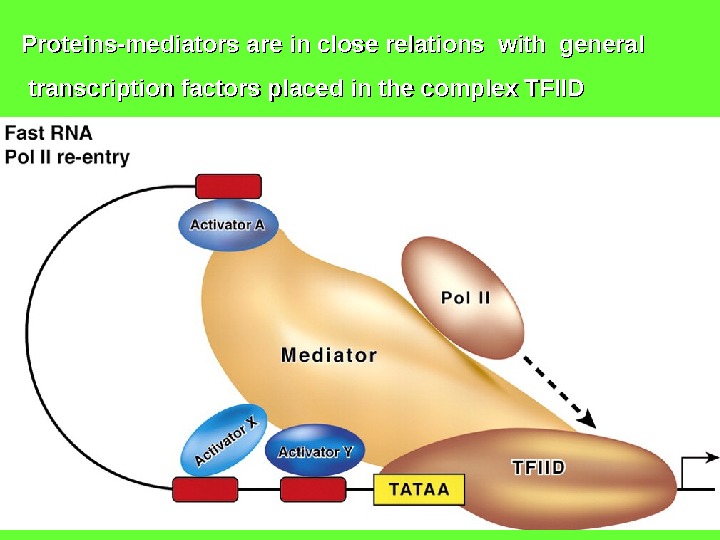
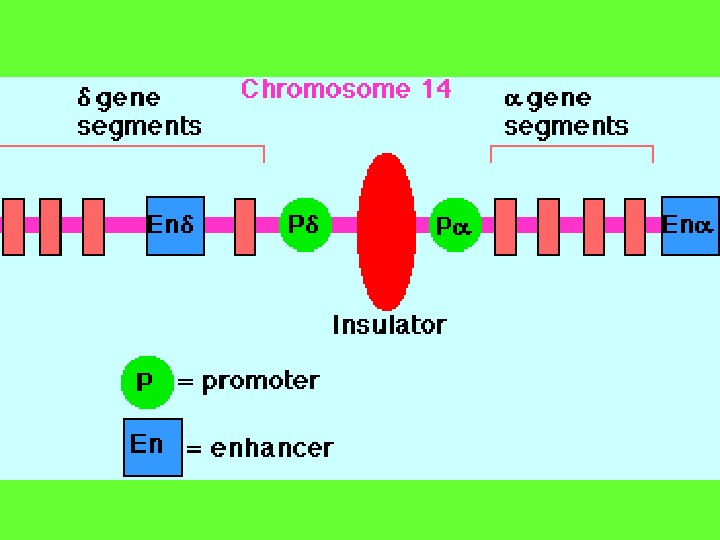
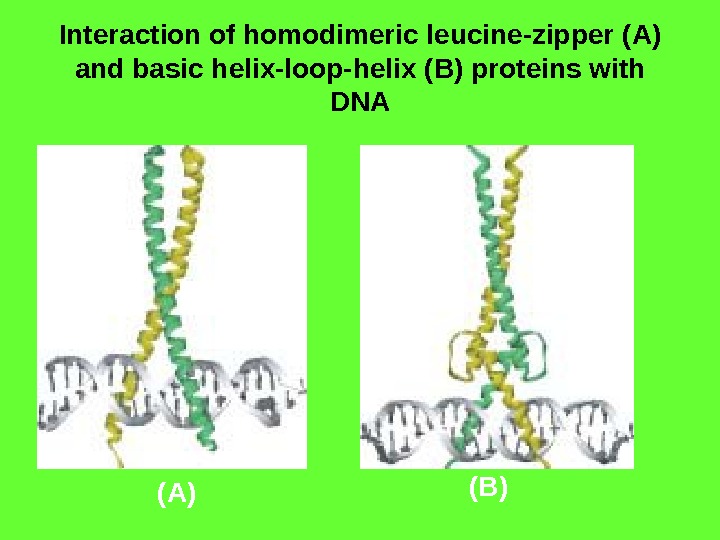
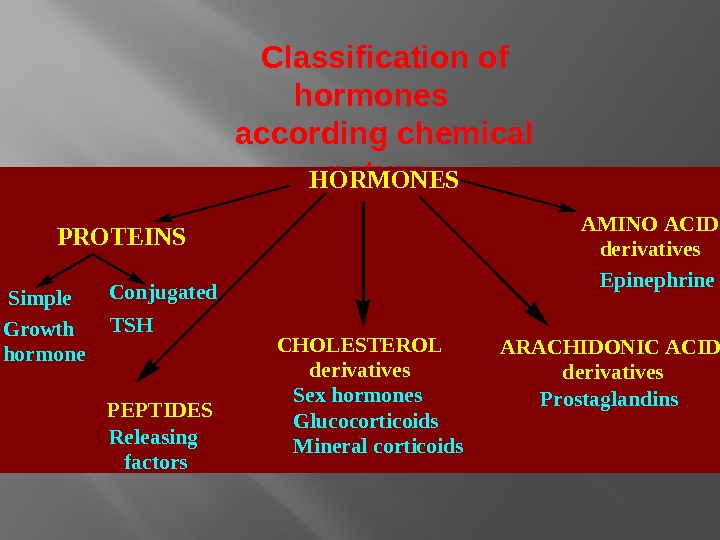
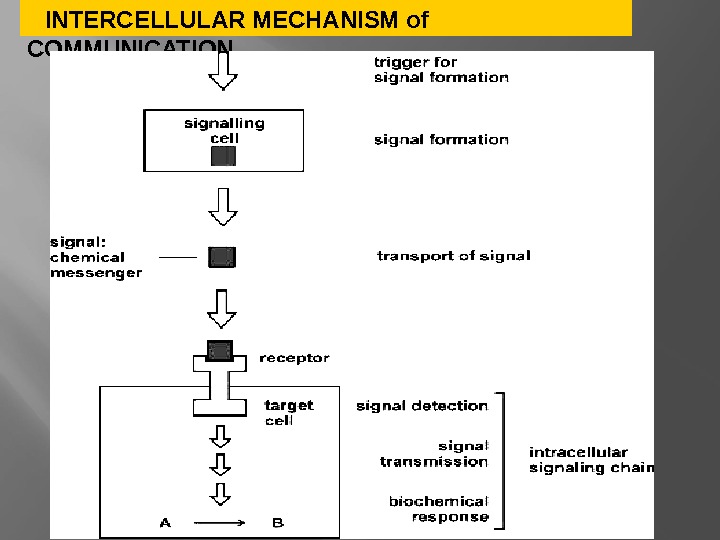
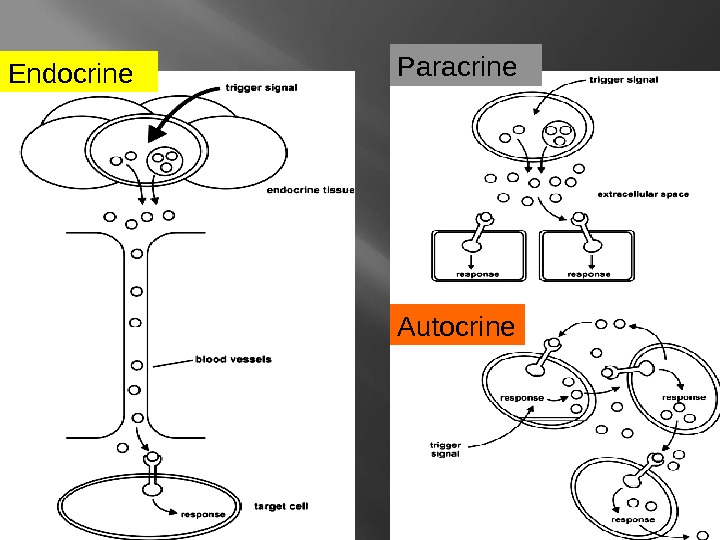
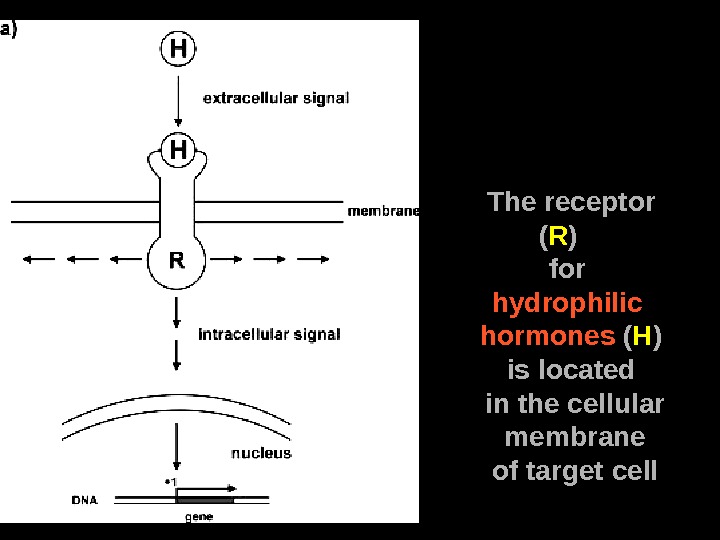
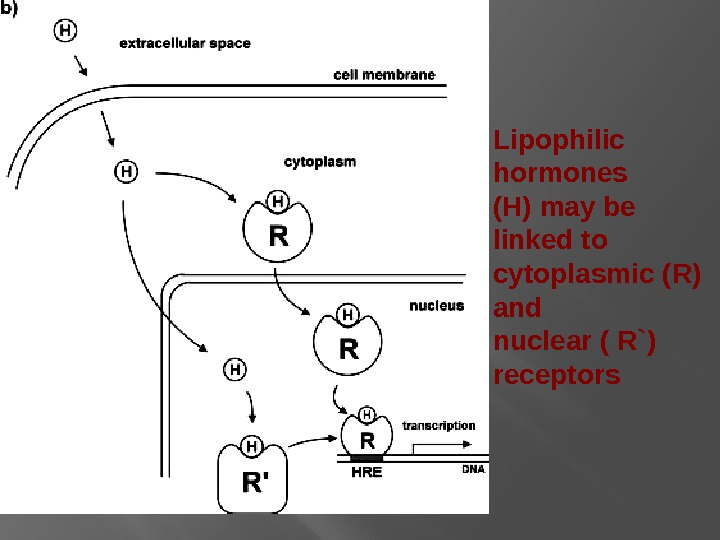
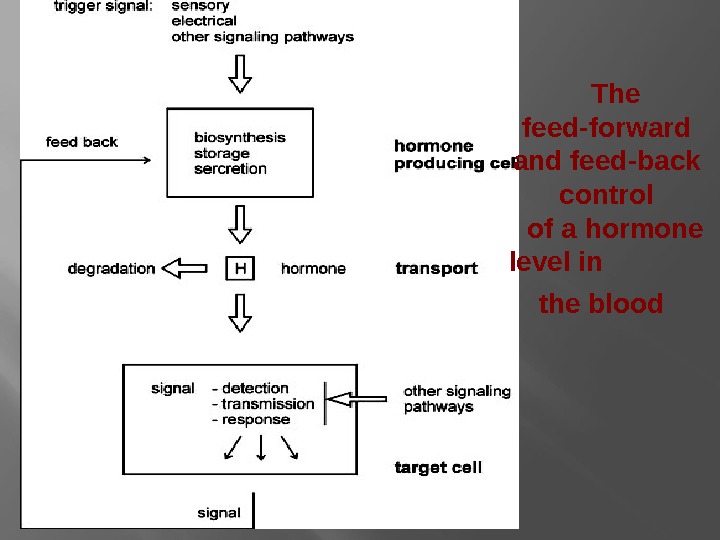
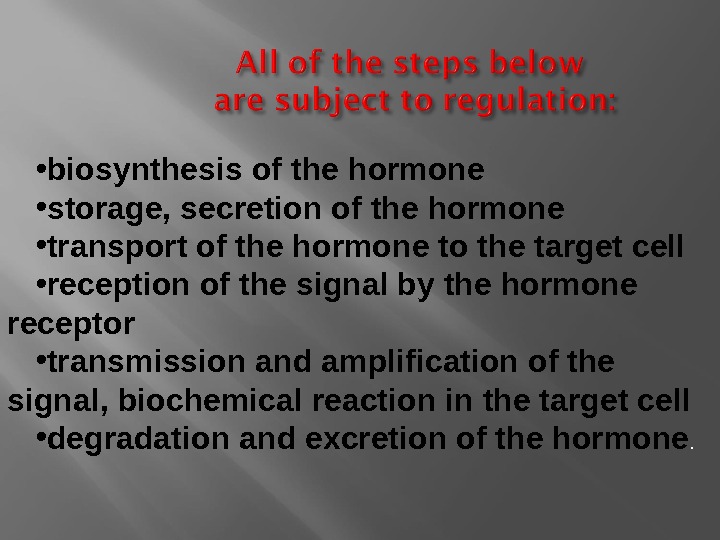

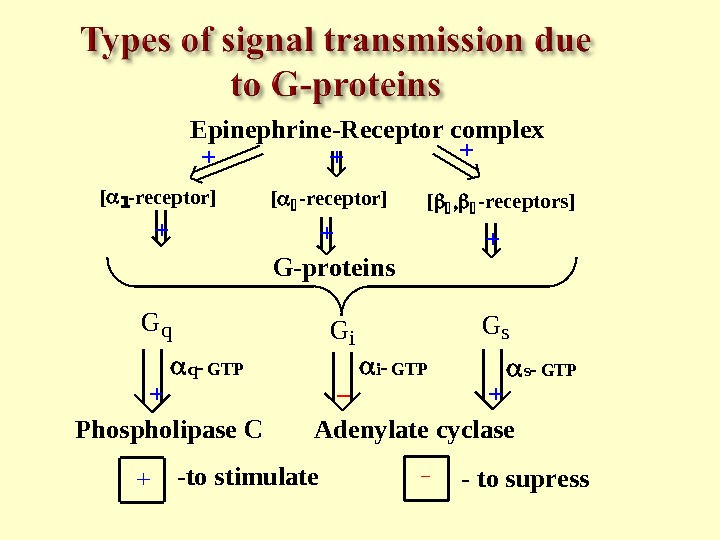
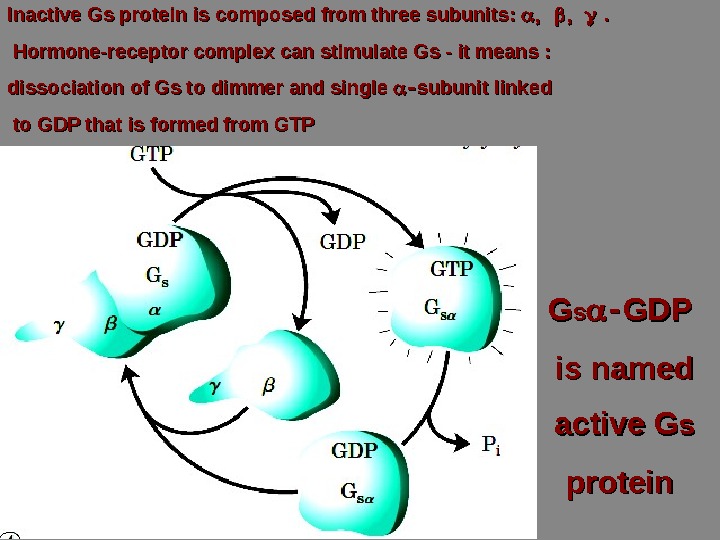
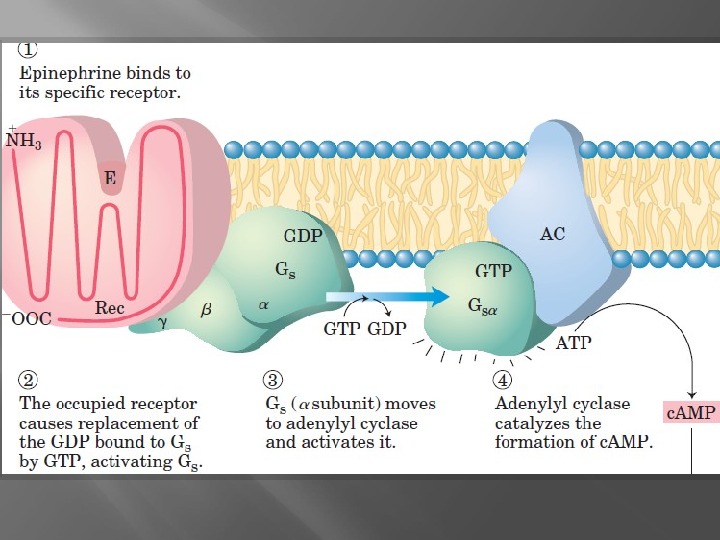
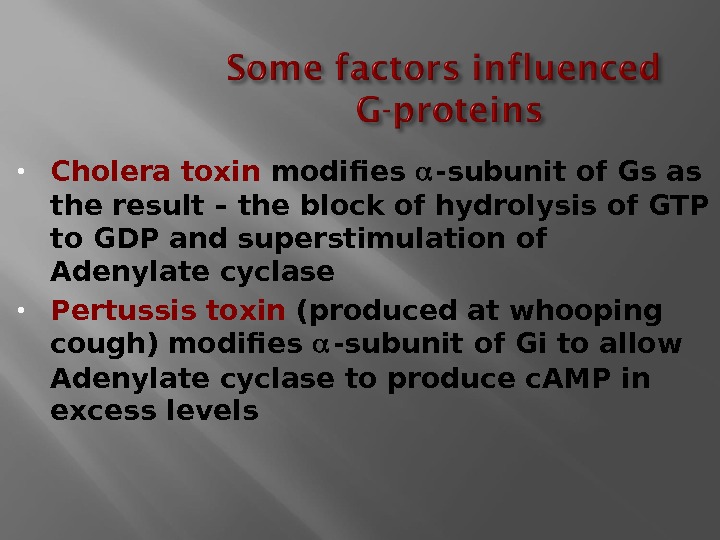
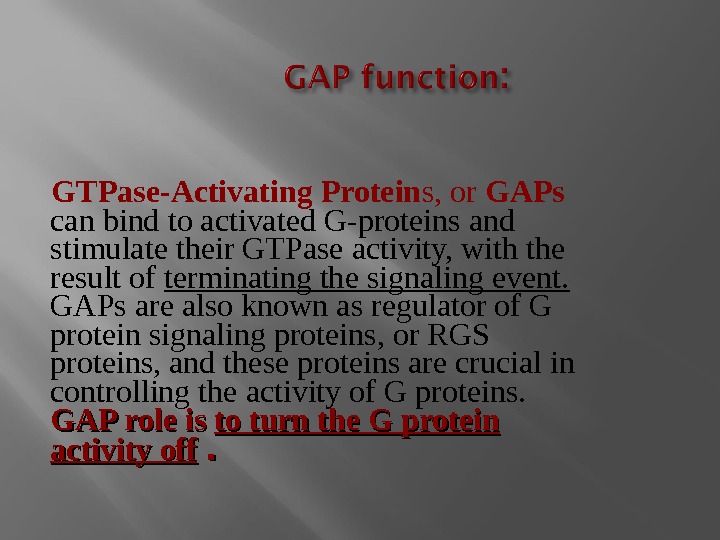
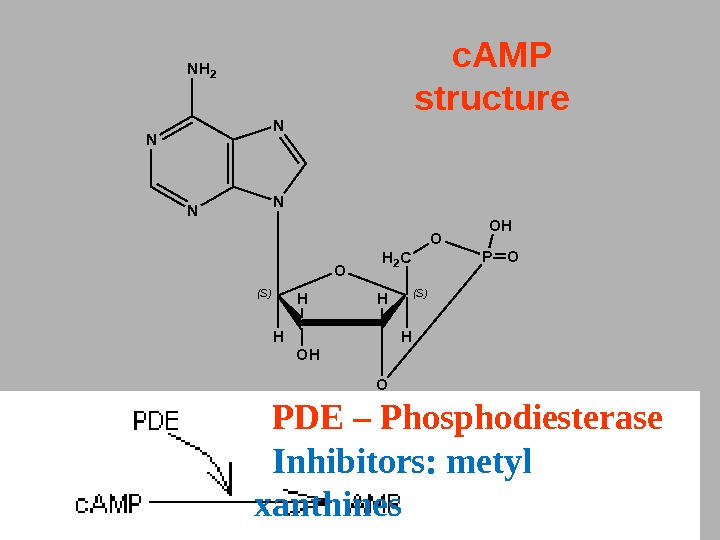
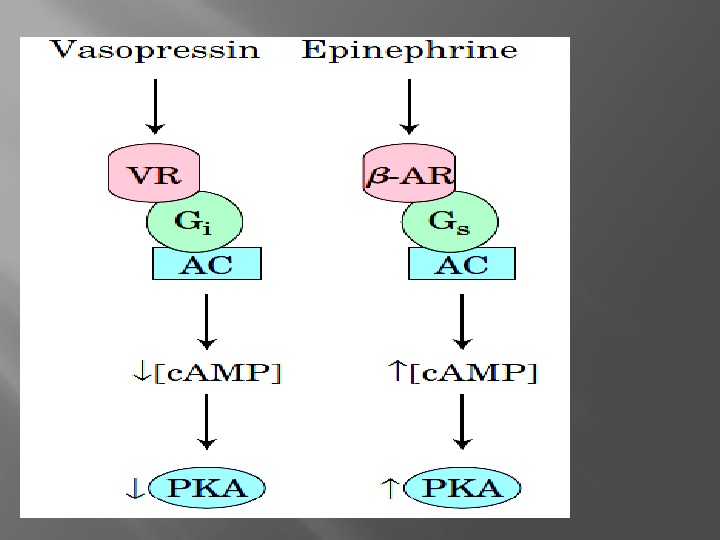
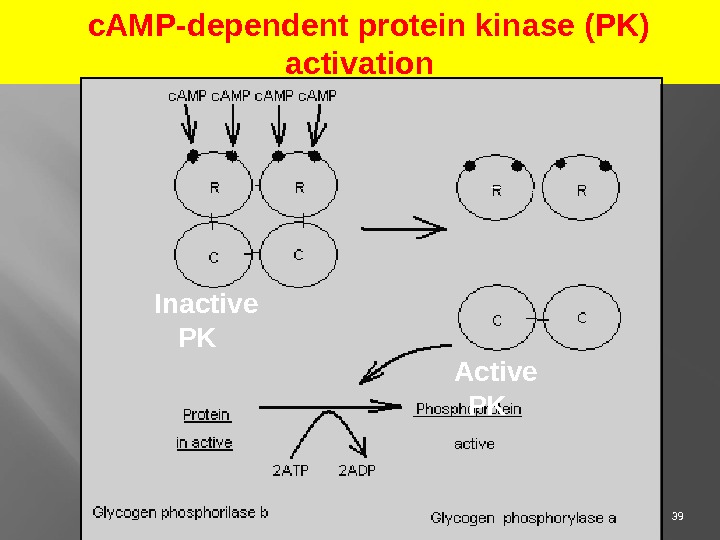
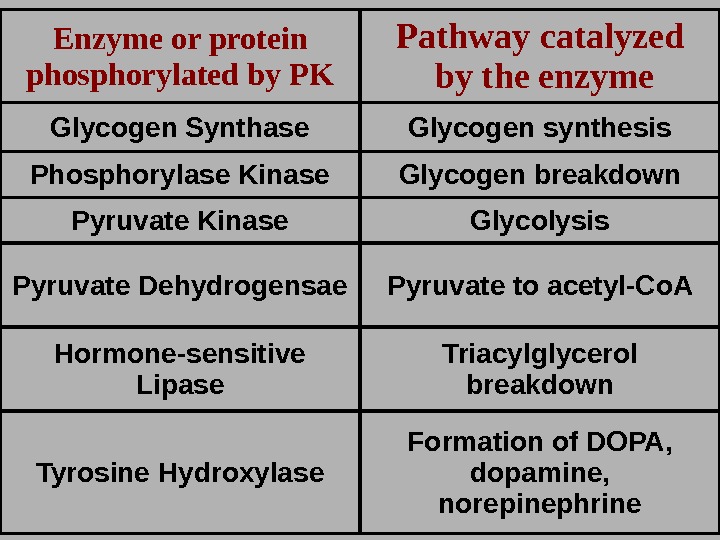
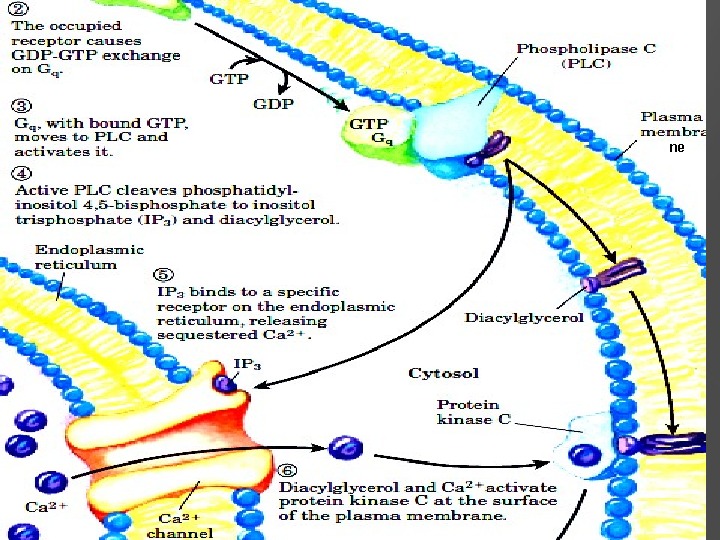
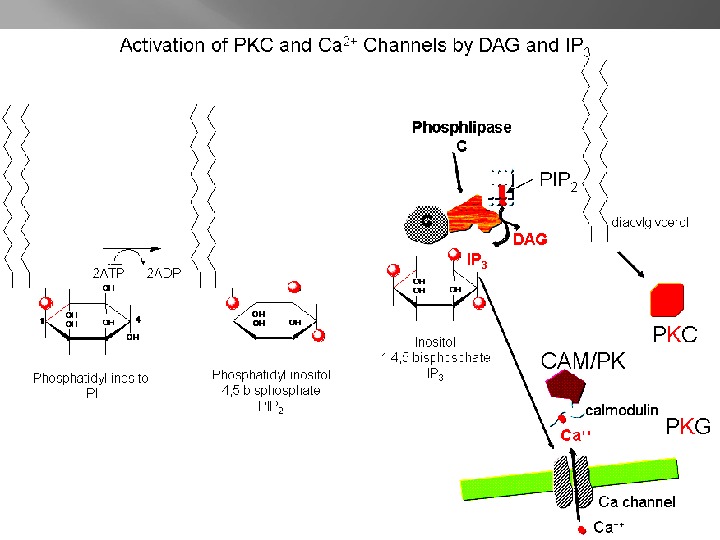
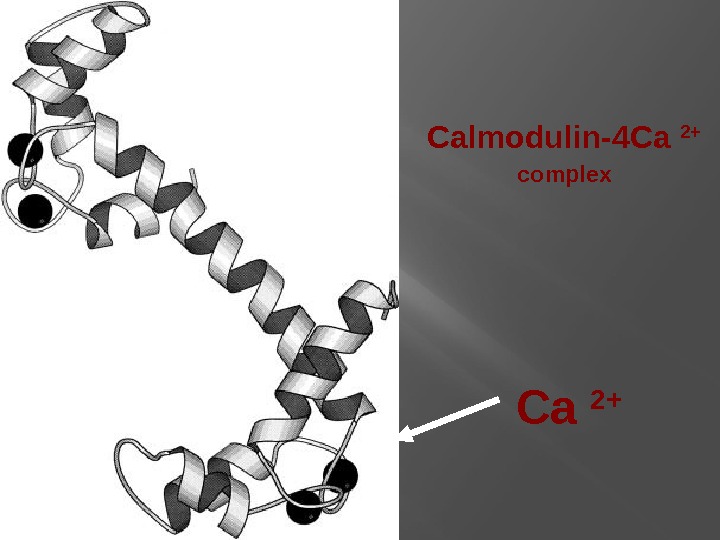
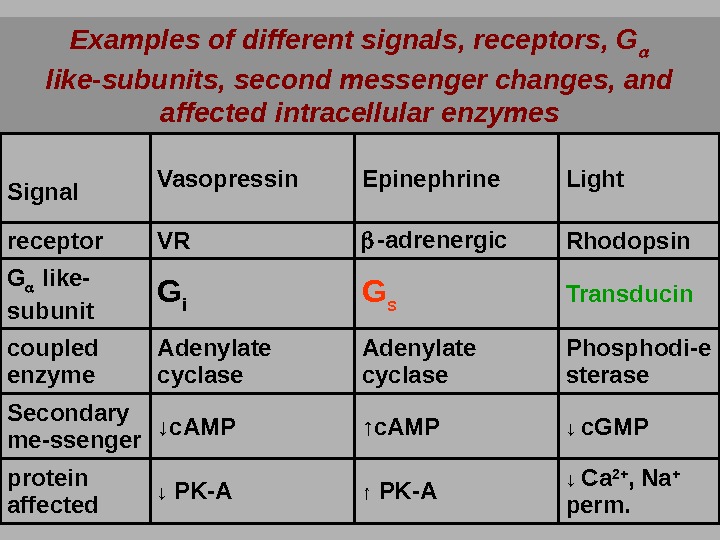
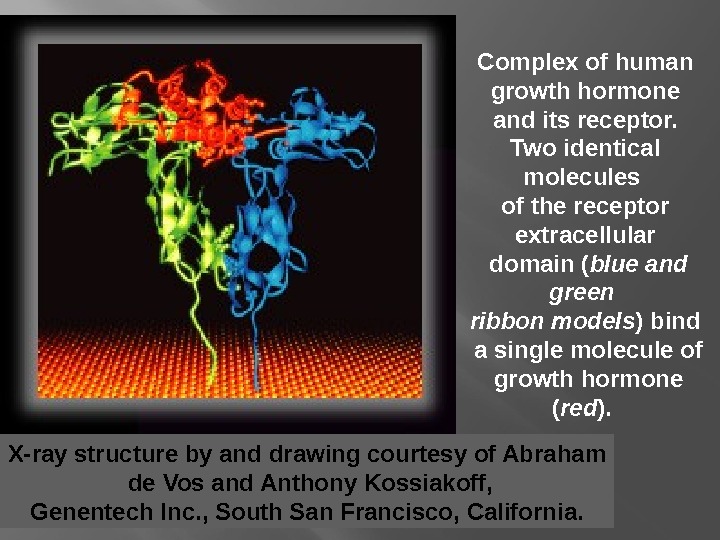
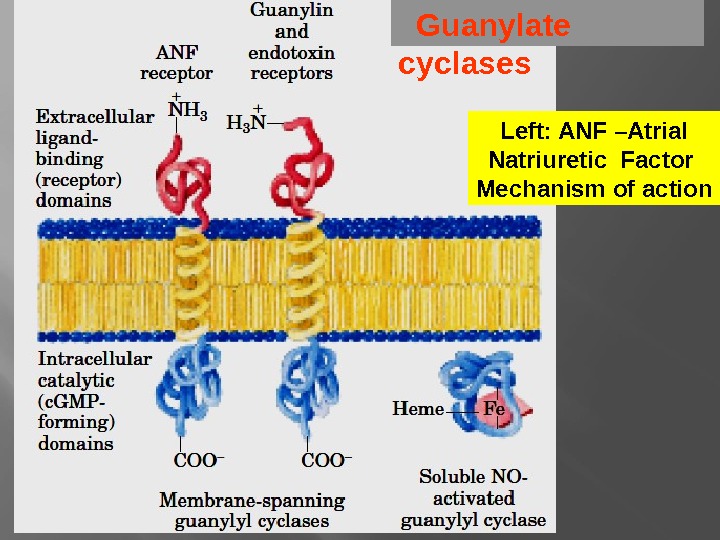
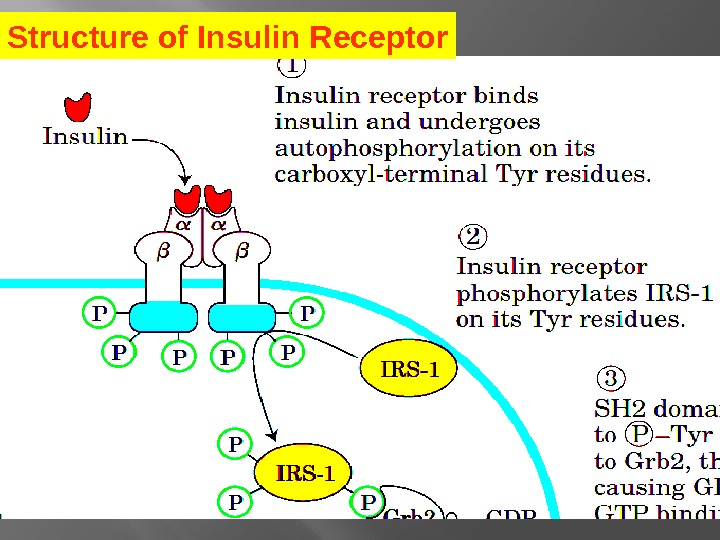
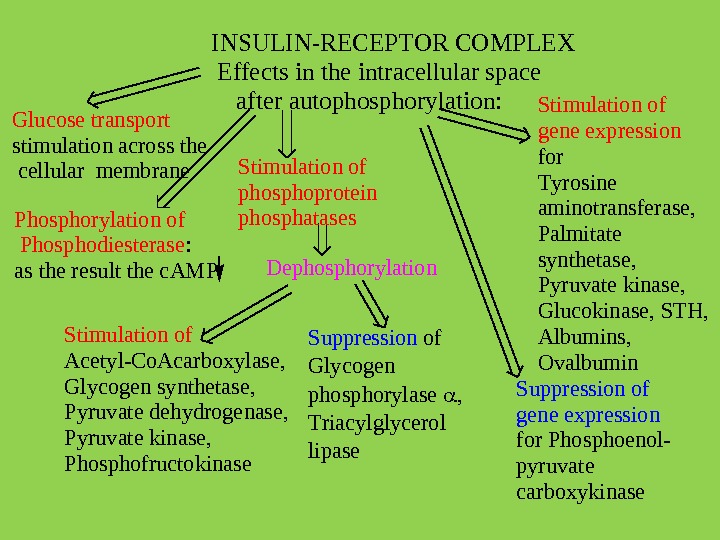
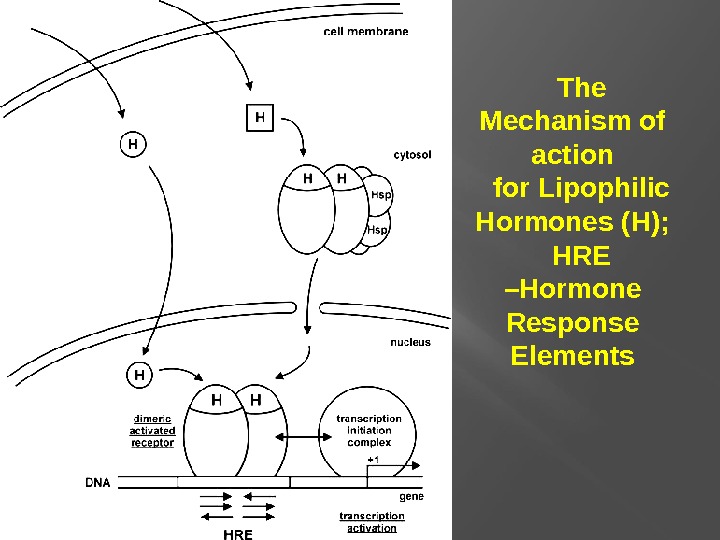


- Размер: 8.1 Mегабайта
- Количество слайдов: 51
Описание презентации Презентация gene exp and hormones part 1 по слайдам
 THE MINISTRY OF PUBLIC HEALTH OF UKRAINE ZAPOROZHYE STATE MEDICAL UNIVERSITY Produced by Ass. professor Krisanova N. V. ,
THE MINISTRY OF PUBLIC HEALTH OF UKRAINE ZAPOROZHYE STATE MEDICAL UNIVERSITY Produced by Ass. professor Krisanova N. V. ,
 All the levels may be regulated: Transcription Processing Translation AAAAAAAGenes of DNA Primary transcript m-RNA Polypeptide chain Modification Substrate A Product B Function. Active protein Gm 3 Intron Exon
All the levels may be regulated: Transcription Processing Translation AAAAAAAGenes of DNA Primary transcript m-RNA Polypeptide chain Modification Substrate A Product B Function. Active protein Gm 3 Intron Exon

 All the genes of DNA in prokaryotic cell are divided in types: • House keeping genes (constitutive) • Inducible (structural) • Gene-regulators • Gene-operators
All the genes of DNA in prokaryotic cell are divided in types: • House keeping genes (constitutive) • Inducible (structural) • Gene-regulators • Gene-operators
 Operon is composed from promoter sequence, gene-operator, structural genes The Lac-operon model investigated in E. coli (proposed by F. Jacob and J. Monod, 1961)
Operon is composed from promoter sequence, gene-operator, structural genes The Lac-operon model investigated in E. coli (proposed by F. Jacob and J. Monod, 1961)
 Gene-regulator is far from operon sequences, it is keeper of information about sequence of amino acid residues in protein-repressor (P-R) molecule Gene-operator is placed in operon between promoter and structural genes, it has affinity to protein- repressor
Gene-regulator is far from operon sequences, it is keeper of information about sequence of amino acid residues in protein-repressor (P-R) molecule Gene-operator is placed in operon between promoter and structural genes, it has affinity to protein- repressor
 Lactose is inducer of transcription made on Lac-operon because of its ability to block activity of P-R and thus to induce m. RNA linkage to the promoter
Lactose is inducer of transcription made on Lac-operon because of its ability to block activity of P-R and thus to induce m. RNA linkage to the promoter
 CRP-c. AMP enhancer influence CRP – Catabolite gene Reactive Protein c. AMP – cyclic AMP
CRP-c. AMP enhancer influence CRP – Catabolite gene Reactive Protein c. AMP – cyclic AMP
 The higher Glucose or Glycerol levels in the intracellular space the lower levels of c. AMP
The higher Glucose or Glycerol levels in the intracellular space the lower levels of c. AMP
 Different Genes are found in eukaryotic DNA • House keeping genes • Genes required during cellular differentiation • Genes which get triggered as a response to some external factors • Genes which get triggered during apoptosis
Different Genes are found in eukaryotic DNA • House keeping genes • Genes required during cellular differentiation • Genes which get triggered as a response to some external factors • Genes which get triggered during apoptosis
 Points for Gene Expression in Eukaryotes – Synthesis of proteins is controlled right from the chromatin stage. – Expression of gene is controlled at many steps during the process of transcription and translation.
Points for Gene Expression in Eukaryotes – Synthesis of proteins is controlled right from the chromatin stage. – Expression of gene is controlled at many steps during the process of transcription and translation.
 Two forms of chromatin : : • Euchromatin – A lesser coiled transcriptionally active region which can be easily accessed by the RNA polymerases. • Heterochromatin – A highly condensed transcriptionally inactive region. The genes in this region cannot be accessed by the RNA polymerases for active transcription.
Two forms of chromatin : : • Euchromatin – A lesser coiled transcriptionally active region which can be easily accessed by the RNA polymerases. • Heterochromatin – A highly condensed transcriptionally inactive region. The genes in this region cannot be accessed by the RNA polymerases for active transcription.
 Mechanisms which affect the chromatin structure and hence the expression of gene are: • Acetylation of Histones : ↑ Acetylation —-↓ Condensation of DNA —— ↑ ↑ Transcription of genes in that region • Methylation of histone H 4 on R 4 (arginine residue at the 4 th position) ->-> opens the chromatin structure ->-> leading to transcriptional activation
Mechanisms which affect the chromatin structure and hence the expression of gene are: • Acetylation of Histones : ↑ Acetylation —-↓ Condensation of DNA —— ↑ ↑ Transcription of genes in that region • Methylation of histone H 4 on R 4 (arginine residue at the 4 th position) ->-> opens the chromatin structure ->-> leading to transcriptional activation
 Mechanisms which affect the chromatin structure and hence the expression of gene are: • Methylation of histone H 3 on K 4 and K 79 (lysine residues at the 4 th and 79 th position) ->-> opens the chromatin structure ->-> leading to transcriptional activation • Methylation of histone H 3 on K 9 and K 27 (lysine residues at the 9 th and 27 th position) ->-> condenses the chromatin structure ->-> leading to transcriptional inactivation
Mechanisms which affect the chromatin structure and hence the expression of gene are: • Methylation of histone H 3 on K 4 and K 79 (lysine residues at the 4 th and 79 th position) ->-> opens the chromatin structure ->-> leading to transcriptional activation • Methylation of histone H 3 on K 9 and K 27 (lysine residues at the 9 th and 27 th position) ->-> condenses the chromatin structure ->-> leading to transcriptional inactivation
 Ubiquitination • Ubiquitination of H 2 A – Transcriptional inactivation • Ubiquitination of H 2 B — Transcriptional activation Methylation of DNA • Target sites of methylation are — The cytidine residues which exist as a dinucleotide, CG (written as Cp. G) • ↑ ↑ methylated cytidine — ↓Transcriptional activity
Ubiquitination • Ubiquitination of H 2 A – Transcriptional inactivation • Ubiquitination of H 2 B — Transcriptional activation Methylation of DNA • Target sites of methylation are — The cytidine residues which exist as a dinucleotide, CG (written as Cp. G) • ↑ ↑ methylated cytidine — ↓Transcriptional activity
 3` 5`
3` 5`
 TATA-box binding protein (TBP) is found in eukaryotic cells, and it is the component of the complex TFIID containing other several proteins (TBP-associated factors) and bound to the TATA boxbox TATA-box binding protein (TBP)
TATA-box binding protein (TBP) is found in eukaryotic cells, and it is the component of the complex TFIID containing other several proteins (TBP-associated factors) and bound to the TATA boxbox TATA-box binding protein (TBP)
 Enhancer-bending protein (EBP) changes the DNA single strand conformation to form special loop which promotes the stimulation and the increase of the rate of initiation phase of transcription.
Enhancer-bending protein (EBP) changes the DNA single strand conformation to form special loop which promotes the stimulation and the increase of the rate of initiation phase of transcription.
 Except EBP and TF, there is the group of mediator proteins to stimulate transcription process, too
Except EBP and TF, there is the group of mediator proteins to stimulate transcription process, too
 Proteins-mediators can control the rate of trans- cription due to their ability to change conformation of their molecules
Proteins-mediators can control the rate of trans- cription due to their ability to change conformation of their molecules
 Proteins-mediators are in close relations with general transcription factors placed in the complex TFII
Proteins-mediators are in close relations with general transcription factors placed in the complex TFII

 Interaction of homodimeric leucine-zipper (A) and basic helix-loop-helix ( B ) proteins with DNA (A) (B)
Interaction of homodimeric leucine-zipper (A) and basic helix-loop-helix ( B ) proteins with DNA (A) (B)
 Classification of hormones according chemical nature H O R M O N E S P R O T E I N S S i m p l e C o n j u g a t e d T S H P E P T I D E S R e l e a s i n g f a c t o r s A M I N O A C I D d e r i v a t i v e s E p i n e p h r i n e C H O L E S T E R O L d e r i v a t i v e s A R A C H I D O N I C A C I D d e r i v a t i v e s P r o s t a g l a n d i n s. S e x h o r m o n e s G l u c o r t i c o i d s M i n e r a l c o r t i c o i d s. G r o w t h h o r m o n e
Classification of hormones according chemical nature H O R M O N E S P R O T E I N S S i m p l e C o n j u g a t e d T S H P E P T I D E S R e l e a s i n g f a c t o r s A M I N O A C I D d e r i v a t i v e s E p i n e p h r i n e C H O L E S T E R O L d e r i v a t i v e s A R A C H I D O N I C A C I D d e r i v a t i v e s P r o s t a g l a n d i n s. S e x h o r m o n e s G l u c o r t i c o i d s M i n e r a l c o r t i c o i d s. G r o w t h h o r m o n e
 INTERCELLULAR MECHANISM of COMMUNICATION
INTERCELLULAR MECHANISM of COMMUNICATION
 Endocrine Paracrine Autocrine
Endocrine Paracrine Autocrine
 The receptor ( R ) for hydrophilic hormones ( H ) is located in the cellular membrane of target cell
The receptor ( R ) for hydrophilic hormones ( H ) is located in the cellular membrane of target cell
 Lipophilic hormones (H) may be linked to cytoplasmic (R) and nuclear ( R`) receptors
Lipophilic hormones (H) may be linked to cytoplasmic (R) and nuclear ( R`) receptors
 The feed-forward and feed-back control of a hormone level in the blood
The feed-forward and feed-back control of a hormone level in the blood
 • biosynthesis of the hormone • storage, secretion of the hormone • transport of the hormone to the target cell • reception of the signal by the hormone receptor • transmission and amplification of the signal, biochemical reaction in the target cell • degradation and excretion of the hormone.
• biosynthesis of the hormone • storage, secretion of the hormone • transport of the hormone to the target cell • reception of the signal by the hormone receptor • transmission and amplification of the signal, biochemical reaction in the target cell • degradation and excretion of the hormone.
 Cerebral cortex T 3 ↑ ↑Cortisol↑↑ Θ ΘCortisol ↑↑ T 3 ↑↑ Glucose↑↑ p. O 2 ↓Cerebral cortex Li ver Myocardi um _ __ _
Cerebral cortex T 3 ↑ ↑Cortisol↑↑ Θ ΘCortisol ↑↑ T 3 ↑↑ Glucose↑↑ p. O 2 ↓Cerebral cortex Li ver Myocardi um _ __ _
 G — p r o t e i n s G q G i G s A d e n y l a t e c y c l a s e_ ++ P h o s p h o l i p a s e CE p i n e p h r i n e — R e c e p t o r c o m p l e x +[ — r e c e p t o r ] [ — r e c e p t o r s ] ++ + ++ q G T P i G T P s G T P + — t o s t i m u l a t e — t o s u p r e s s_
G — p r o t e i n s G q G i G s A d e n y l a t e c y c l a s e_ ++ P h o s p h o l i p a s e CE p i n e p h r i n e — R e c e p t o r c o m p l e x +[ — r e c e p t o r ] [ — r e c e p t o r s ] ++ + ++ q G T P i G T P s G T P + — t o s t i m u l a t e — t o s u p r e s s_
 Inactive Gs protein is composed from three subunits: . . Hormone-receptor complex can stimulate Gs — it means : dissociation of Gs to dimmer and single subunit linked to GDP that is formed from GTP GG ss GDPGDP is named active G ss protein
Inactive Gs protein is composed from three subunits: . . Hormone-receptor complex can stimulate Gs — it means : dissociation of Gs to dimmer and single subunit linked to GDP that is formed from GTP GG ss GDPGDP is named active G ss protein

 Cholera toxin modifies -subunit of Gs as the result – the block of hydrolysis of GTP to GDP and superstimulation of Adenylate cyclase Pertussis toxin (produced at whooping cough) modifies -subunit of Gi to allow Adenylate cyclase to produce c. AMP in excess levels
Cholera toxin modifies -subunit of Gs as the result – the block of hydrolysis of GTP to GDP and superstimulation of Adenylate cyclase Pertussis toxin (produced at whooping cough) modifies -subunit of Gi to allow Adenylate cyclase to produce c. AMP in excess levels
 GTPase-Activating Protein s, or GAPs can bind to activated G-proteins and stimulate their GTPase activity, with the result of terminating the signaling event. GAPs are also known as regulator of G protein signaling proteins, or RGS proteins, and these proteins are crucial in controlling the activity of G proteins. GAP role is to turn the G protein activity off . .
GTPase-Activating Protein s, or GAPs can bind to activated G-proteins and stimulate their GTPase activity, with the result of terminating the signaling event. GAPs are also known as regulator of G protein signaling proteins, or RGS proteins, and these proteins are crucial in controlling the activity of G proteins. GAP role is to turn the G protein activity off . .
 N N NNN H 2 ( S ) O HH H 2 C H O P OO H O c. AMP structure PDE – Phosphodiesterase Inhibitors: metyl xanthines
N N NNN H 2 ( S ) O HH H 2 C H O P OO H O c. AMP structure PDE – Phosphodiesterase Inhibitors: metyl xanthines

 39 c. AMP-dependent protein kinase (PK) activation Inactive PK Active PK _
39 c. AMP-dependent protein kinase (PK) activation Inactive PK Active PK _
 Enzyme or protein phosphorylated by PK Pathway catalyzed by the enzyme Glycogen Synthase G lycogen synthesis Phosphorylase Kinase G lycogen breakdown Pyruvate Kinase Glycolysis Pyruvate Dehydrogensae Pyruvate to acetyl-Co. A Hormone-sensitive Lipase Triacylgly c er ol breakdown Tyrosine Hydroxylase Formation of DOPA, dopamine, norepinephrine
Enzyme or protein phosphorylated by PK Pathway catalyzed by the enzyme Glycogen Synthase G lycogen synthesis Phosphorylase Kinase G lycogen breakdown Pyruvate Kinase Glycolysis Pyruvate Dehydrogensae Pyruvate to acetyl-Co. A Hormone-sensitive Lipase Triacylgly c er ol breakdown Tyrosine Hydroxylase Formation of DOPA, dopamine, norepinephrine
 ne
ne

 Calmodulin-4 Ca 2+ complex Ca 2+
Calmodulin-4 Ca 2+ complex Ca 2+
 Examples of different signals, receptors, G like-subunits, second messenger changes, and affected intracellular enzymes S ignal Vasopressin Epinephrine L ight receptor VR -adrenergic Rhodopsin G like- subunit G i G s Transducin coupled enzyme Adenylate cyclase Phosphodi — e sterase Secondary me — ssenger ↓ c. AMP ↑ c. AMP ↓ c. GMP protein affected ↓ PK-A ↑ PK-A ↓ Ca 2+ , Na + perm.
Examples of different signals, receptors, G like-subunits, second messenger changes, and affected intracellular enzymes S ignal Vasopressin Epinephrine L ight receptor VR -adrenergic Rhodopsin G like- subunit G i G s Transducin coupled enzyme Adenylate cyclase Phosphodi — e sterase Secondary me — ssenger ↓ c. AMP ↑ c. AMP ↓ c. GMP protein affected ↓ PK-A ↑ PK-A ↓ Ca 2+ , Na + perm.
 X-ray structure by and drawing courtesy of Abraham de Vos and Anthony Kossiakoff, Genentech Inc. , South San Francisco, California. C omplex of human growth hormone and its receptor. Two identical molecules of the receptor extracellular domain ( blue and green ribbon models ) bind a single molecule of growth hormone ( red ).
X-ray structure by and drawing courtesy of Abraham de Vos and Anthony Kossiakoff, Genentech Inc. , South San Francisco, California. C omplex of human growth hormone and its receptor. Two identical molecules of the receptor extracellular domain ( blue and green ribbon models ) bind a single molecule of growth hormone ( red ).
 Guanylate cyclases Left: ANF –Atrial Natriuretic Factor Mechanism of action
Guanylate cyclases Left: ANF –Atrial Natriuretic Factor Mechanism of action
 Structure of Insulin Receptor
Structure of Insulin Receptor
 INSULIN-RECEPTOR COMPLEX Effects in the intracellular space after autophosphorylation: Glucose transport stimulation across the cellular membrane Phosphorylation of Phosphodiesterase: as the result the c. AMP Stimulation of phosphoprotein phosphatases Dephosphorylation Stimulation of Acetyl-Co. Acarboxylase, Glycogen synthetase, Pyruvate dehydrogenase, Pyruvate kinase, Phosphofructokinase Suppression of Glycogen phosphorylase , Triacylglycerol lipase Stimulation of gene expression for Tyrosine aminotransferase, Palmitate synthetase, Pyruvate kinase, Glucokinase, STH, Albumins, Ovalbumin Suppression of gene expression for Phosphoenol- pyruvate carboxykinase
INSULIN-RECEPTOR COMPLEX Effects in the intracellular space after autophosphorylation: Glucose transport stimulation across the cellular membrane Phosphorylation of Phosphodiesterase: as the result the c. AMP Stimulation of phosphoprotein phosphatases Dephosphorylation Stimulation of Acetyl-Co. Acarboxylase, Glycogen synthetase, Pyruvate dehydrogenase, Pyruvate kinase, Phosphofructokinase Suppression of Glycogen phosphorylase , Triacylglycerol lipase Stimulation of gene expression for Tyrosine aminotransferase, Palmitate synthetase, Pyruvate kinase, Glucokinase, STH, Albumins, Ovalbumin Suppression of gene expression for Phosphoenol- pyruvate carboxykinase
 The Mechanism of action for Lipophilic Hormones (H); HRE –Hormone Response Elements
The Mechanism of action for Lipophilic Hormones (H); HRE –Hormone Response Elements
 They have affinity to receptors of steroidal hormone containing so named “ zink-fingers”AF 1, AF 2 domains that mediate the stimulation of the transcription
They have affinity to receptors of steroidal hormone containing so named “ zink-fingers”AF 1, AF 2 domains that mediate the stimulation of the transcription
 51 THANK YOU For ATTENTION !
51 THANK YOU For ATTENTION !

